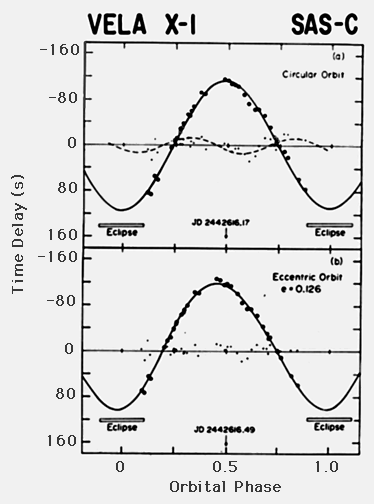Vela X-1 Orbital ModulationVela X-1 is a massive X-ray binary in which the compact object is an x-ray pulsar, and the primary is an OB Supergiant. Because one can observe the Doppler shift in pulse arrival times from the pulsar simultaneously with the Doppler shift in spectral lines from the OB star, Vela X-1 is one of the few systems that can be treated as a double-lined spectroscopic variable. This is a very accurate way of measuring the masses of each component of the binary system independently. Currently, the mass of the OB star is measured to be 23 solar masses, while the pulsar weighs in at 1.77 solar masses, the highest measured value of a pulsar mass. Determining neutron star masses has important ramifications for the theoretical studies of equations of state of degenerate matter, an ongoing field of research which places upper bounds on the maximum stable neutron star mass. The figure below shows the Doppler shift of the X-ray pulsar period (283 seconds) in terms of the "time delay", i.e., the number of seconds that the main pulse was late or early, as a function of orbital phase. (The orbit is 8.9 days.) The range of time delay for the pulsar is ~ +/- 120 seconds over a single orbit. Since the pulse period is relatively short, it is possible to obtain a very accurate measure of the delay time for each observation about the orbit of the system. With such accurate data, models can be fit to solve for the orbital parameters of the system, such as eccentricity and periastron. The figure in the top panel shows, in addition to the time delay, the deviation of the time delay from what would be expected for a circular orbit. Using these offsets, one can solve for the eccentricity of the system. A neutron star in an eccentric orbit about the primary displays a time delay function that deviates from sinusoidal during the orbit. In the lower panel, the time delay data has been fit to a model orbit with eccentricity = 0.092; note that the deviations are now very close to zero.
IMAGES |
By Mission |
Stars |
HEASARC Home | Observatories | Archive | Calibration | Software | Tools | Students/Teachers/Public Last modified: Thursday, 26-Jun-2003 13:48:45 EDT HEASARC Staff Scientist Position - Applications are now being accepted for a Staff Scientist with significant experience and interest in the technical aspects of astrophysics research, to work in the High Energy Astrophysics Science Archive Research Center (HEASARC) at NASA Goddard Space Flight Center (GSFC) in Greenbelt, MD. Refer to the AAS Job register for full details. |


